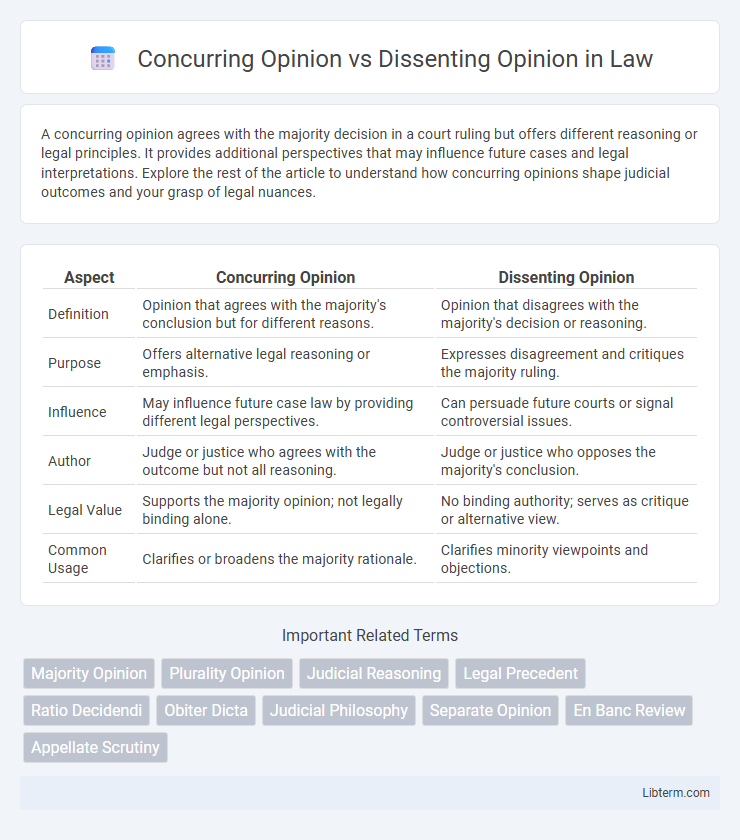A concurring opinion agrees with the majority decision in a court ruling but offers different reasoning or legal principles. It provides additional perspectives that may influence future cases and legal interpretations. Explore the rest of the article to understand how concurring opinions shape judicial outcomes and your grasp of legal nuances.
Table of Comparison
| Aspect | Concurring Opinion | Dissenting Opinion |
|---|---|---|
| Definition | Opinion that agrees with the majority's conclusion but for different reasons. | Opinion that disagrees with the majority's decision or reasoning. |
| Purpose | Offers alternative legal reasoning or emphasis. | Expresses disagreement and critiques the majority ruling. |
| Influence | May influence future case law by providing different legal perspectives. | Can persuade future courts or signal controversial issues. |
| Author | Judge or justice who agrees with the outcome but not all reasoning. | Judge or justice who opposes the majority's conclusion. |
| Legal Value | Supports the majority opinion; not legally binding alone. | No binding authority; serves as critique or alternative view. |
| Common Usage | Clarifies or broadens the majority rationale. | Clarifies minority viewpoints and objections. |
Understanding Judicial Opinions
Concurring opinions agree with the majority's decision but emphasize different legal reasoning or principles, providing alternative perspectives on the case outcome. Dissenting opinions disagree with the majority's ruling and present counterarguments, often influencing future legal interpretations or reforms. Understanding these judicial opinions enriches comprehension of court decisions and highlights the complexity of legal reasoning within appellate courts.
Definition of Concurring Opinion
A concurring opinion is a judicial opinion written by one or more judges who agree with the majority's decision but want to express different legal reasoning or emphasize specific points. This opinion supports the ultimate judgment while highlighting alternative legal perspectives or interpretations. Concurring opinions contribute to legal discourse by providing varied viewpoints within the same case outcome.
Definition of Dissenting Opinion
A dissenting opinion is a judicial opinion written by one or more judges expressing disagreement with the majority's decision in a court case. It highlights alternative legal reasoning or interpretations that oppose the outcome reached by the majority of the panel. Dissenting opinions do not hold binding authority but can influence future legal arguments and jurisprudence.
Key Differences Between Concurring and Dissenting Opinions
Concurring opinions agree with the majority's final decision but emphasize different legal reasoning or principles, while dissenting opinions oppose the majority's conclusion entirely. Key differences include the concurring opinion's support for the outcome with alternative logic versus the dissenting opinion's rejection of both outcome and reasoning. Concurring opinions can influence future case law by providing alternative interpretations, whereas dissenting opinions often highlight minority viewpoints and potential legal flaws.
Purpose and Significance of Concurring Opinions
Concurring opinions provide alternative legal reasoning or emphasize specific aspects of a case while agreeing with the majority's outcome, enriching judicial interpretation and guiding future cases. They clarify nuances in the law without opposing the court's decision, often influencing later rulings and legal scholarship by highlighting differing perspectives. This significance lies in their ability to shape legal doctrine and offer a more comprehensive understanding of judicial reasoning beyond the majority opinion.
Purpose and Significance of Dissenting Opinions
Dissenting opinions serve the purpose of expressing disagreement with the majority ruling in a court case, providing alternative interpretations of the law that can influence future legal arguments and judicial decisions. They hold significant value in preserving legal debate, promoting the development of law, and sometimes paving the way for future shifts in jurisprudence. By documenting opposing viewpoints, dissenting opinions contribute to transparency and ensure that the judiciary reflects diverse legal reasoning.
Impact on Legal Precedent
Concurring opinions agree with the majority's conclusion but emphasize different legal reasoning, potentially shaping future interpretations and influencing the evolution of legal doctrines. Dissenting opinions oppose the majority's decision and, while not binding, can inspire legal reform and eventually become persuasive precedent if courts reconsider the issues. Both types of opinions contribute to the dynamic development of case law by highlighting alternative perspectives within judicial reasoning.
Examples From Landmark Cases
Concurring opinions in landmark cases, such as Justice Potter Stewart's concurrence in *Jacobellis v. Ohio* (1964), offer an alternative legal rationale that agrees with the majority outcome but emphasizes different constitutional grounds. Dissenting opinions, exemplified by Justice John Marshall Harlan's famous dissent in *Plessy v. Ferguson* (1896), reject the majority's ruling and present arguments that often influence future legal developments by highlighting civil rights concerns. These opinions play crucial roles in shaping judicial interpretation and can guide subsequent case law and legal scholarship.
Pros and Cons of Judicial Disagreement
Concurring opinions provide judges the opportunity to agree with the majority's conclusion while offering different legal reasoning, which can enrich judicial interpretation but may create confusion over the binding precedent. Dissenting opinions highlight alternative viewpoints and can influence future legal developments or reforms, yet they may also undermine the perceived unanimity and authority of the court. Judicial disagreement fosters a dynamic legal system by encouraging debate and diverse perspectives, though excessive divergence risks judicial inconsistency and uncertainty in law application.
The Role of Separate Opinions in Shaping the Law
Concurring opinions provide alternative reasoning that supports the majority judgment, offering insights that can influence future legal interpretations and doctrinal development. Dissenting opinions, while opposing the majority ruling, serve as vital critiques that may inspire legal reform and signal shifts in judicial perspectives over time. Both separate opinions play a crucial role in shaping the law by enriching judicial discourse and guiding subsequent case law evolution.
Concurring Opinion Infographic

 libterm.com
libterm.com